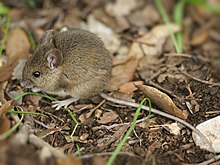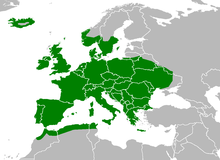Wood mouse
| Wood mouse | |
|---|---|
 |
|
| Scientific classification | |
| Kingdom: | Animalia |
| Phylum: | Chordata |
| Class: | Mammalia |
| Order: | Rodentia |
| Superfamily: | Muroidea |
| Family: | Muridae |
| Subfamily: | Murinae |
| Genus: | Apodemus |
| Species: | A. sylvaticus |
| Binomial name | |
|
Apodemus sylvaticus (Linnaeus, 1758) |
|
 |
|
| Apodemus sylvaticus range (in green) | |
The wood mouse (Apodemus sylvaticus) is a common murid rodent from Europe and northwestern Africa. It is closely related to the yellow-necked mouse (Apodemus flavicollis) but differs in that it has no band of yellow fur around the neck, has slightly smaller ears, and is usually slightly smaller overall: around 90 mm (3.54 in) in length. It is found across most of Europe and is a very common and widespread species, is commensal with people and is sometimes considered a pest. Other common names are long-tailed field mouse, field mouse, common field mouse, and European wood mouse.
Wood mice inhabit forests, grasslands, and cultivated fields. Almost entirely nocturnal and terrestrial, wood mice burrow extensively, build nests of plants and live in buildings during harsh seasons. It is one of the most intensively studied species in the genus. In Europe it ranges north to Scandinavia and east to Ukraine. The wood mouse is also found in northwestern Africa and on many Mediterranean islands.
Wood mice are primarily seed eaters, particularly seeds of trees such as oak, beech, ash, lime, hawthorn, and sycamore. If seeds are plentiful on the ground, they carry them back to their nests/burrows for storage. They may eat small invertebrates such as snails and insects, particularly in late spring and early summer when seeds are least available. They also consume berries, fruits, and roots. During the colder months, wood mice do not hibernate; however, during severe winter seasons they fall into a sort of torpor, a decrease in physiological activity. They are mainly active during the dark, and are very good climbers. While foraging, wood mice pick up and distribute visually conspicuous objects, such as leaves and twigs, which they then use as landmarks during exploration. If a wood mouse is caught by its tail, it can quickly shed the end of it, which may never regrow. Despite its name, it prefers hedgerows to woodland. To prevent predation, wood mice tend to forage in covered microsites.
The wood mouse has a breeding season from February to October in which multiple matings occur between males and females, resulting in scramble competition. Such behavioral characteristics result in sperm competition and multiple paternity litters. The society is polygynous with copulation resulting from scramble competition during reproductive periods. Males possess a known as the cauda epididymis, which stores sperm and lies underneath the scrotal protrusion. Temperature regulation ensures maximum sperm output.
...
Wikipedia

